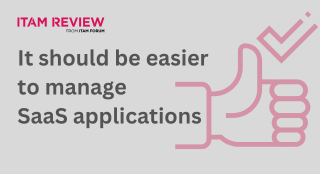Rethinking SaaS Procurement: Why Reseller model is ripe for disruption
The following article about rethinking SaaS procurement amid the disruption caused by the rise of “citizen SaaS buyers” was written by Nidhi Jain, CEO and Co-founder of CloudEagle.
SaaS applications help organizations increase employee productivity, transform business operations, and increase revenue without the hassles of months-long IT implementation and setup. However, organizations often face challenges when researching and buying SaaS applications.
In the world of SaaS buying, things can get tricky. Conventional ways of procuring software through resellers may not be optimal. This is because most resellers are vested in pushing a few select vendors where they have preferred commercials rather than focusing on what customers want.

Previously, the reseller model made sense when customers were supposed to choose from a few vendors. However, innovative new companies and products are built daily in the new era of SaaS and AI. Customers may lose out if they have to choose from a select few vendors that the reseller works with.
If the price were a factor in going with resellers, I would argue that customers might be better off negotiating with vendors themselves, as vendors are quite amenable to giving customers the best price given the competitive landscape, so why involve middlemen?
Resellers make it harder for businesses to find the right software and make things more complicated than they need to be.
But here’s the exciting part: the disruption is coming. Newer ways of buying software focus more on customers’ needs than closing sales. These new modern-day procurement platforms are like a breath of fresh air, making it easier for businesses to get the right software at the right price without all the hassles of going through middlemen.
We are already seeing the reseller market get disrupted. Let’s dive in and see how things are changing for the better!
Challenges in the reseller model for SaaS procurement
The reseller model, a longstanding software procurement norm, is ripe for disruption. Even though it has been a go-to method for software purchasing for a long time, its flaws are becoming increasingly apparent.
These challenges primarily include a lack of transparency, pricing discrepancies, limited vendors to choose from, and limited control over the procurement process. However, one of the significant challenges I encountered while engaging with customers and peers is that resellers prioritize sales objectives rather than catering to the specific requirements of purchasing organizations.
I believe the crux of the issue lies in how resellers partner with specific vendors to prioritize their sales targets over aligning solutions with the genuine needs of buying organizations.
So, this conventional way of buying software, where resellers call the shots, is changing. This disruption empowers buyers, offering them comprehensive data to make informed purchasing decisions based on the data.
It’s not just the disruption in procurement. There’s massive disruption in vendor solutions as well. Let’s take scheduling meetings, for example, traditional calendaring solutions are being disrupted with new tools that provide flexible scheduling options and eliminate the back-and-forth communication often associated with conventional calendars.
Even prominent IAM solutions like Okta are being disrupted by new robust tools, such as Auth0 and OneLogin, which use innovative technologies and flexible integrations, challenging Okta’s established position.
Procurement platforms are disrupting SaaS procurement
Procurement platforms are disrupting the SaaS procurement space. By providing all the data and insights to the end customer, the customer can find the right tool at the right price.
With the power of machine learning & AI, these platforms surface the right software for the customer’s unique needs so they can optimize their software dollars and fast-track the buying process.
Customers don’t have to stress about knowing industry jargon or reading dense Gartner reports, or searching multiple review websites.
The large language models narrow the search to a few relevant choices; customers type the business problem they are looking to solve and can now get a shortlist of SaaS vendors – this helps them discover new, relevant vendors without being bogged down by vendors with the most marketing dollars.
For renewals, benchmarking data and understanding usage insights give customers the unique edge to negotiate with vendors. By doing this, they don’t have to rely on resellers to get discounts from some select vendors.
Moreover, these platforms help automate the complex, repetitive tasks of approving purchase requests, providing negotiation assistance, etc.
The right platform
Procurement platforms that automate procurement while assisting customers in navigating the SaaS and AI vendor landscape by providing data and insights are the right partners to choose from.
These platforms seek to democratize the procurement process by connecting buyers and sellers directly. Rather than being driven solely by sales targets or vendor preferences, these new approaches evaluate how well the software aligns with the customer’s requirements.
They enable direct engagement between end-users and vendors, ensuring that the software features are personalized to address specific needs rather than offering generic solutions.
Unlike reseller models, customer-centric approaches adopted by procurement platforms lead to a more streamlined and effective procurement process by enabling direct interactions and complete transparency.
The future of SaaS procurement
In conclusion, the landscape of SaaS procurement is significantly shifting from conventional reseller models to customer-centric direct-from-vendor data and AI-enabled procurement platforms. The challenges resellers pose, from limited transparency to misaligned solutions, have paved the way for disruptive changes in how organizations acquire software.
This transformation is driven by empowering buyers, providing transparent information, and direct vendor interactions. The shift towards customer-centricity aims to ensure that SaaS solutions are tailored precisely to each organization’s unique needs, enhancing efficiency, optimizing spending, and maximizing value.
As these disruptive procurement platforms continue to gain popularity, the future of SaaS procurement appears promising, promising a more agile, personalized, and value-driven approach that puts the customer’s requirements at the forefront.
Can’t find what you’re looking for?
More from ITAM News & Analysis
-
83% of IT Managers Believe their Asset Data is Highly Accurate - Only 35% of the Business Agrees
New and interesting research from WanAware hits at the nub of the disconnect many IT Asset Managers might feel about the value they deliver. The ‘Closing the ITAM Confidence Gap. 2025 Survey Insights for IT Leaders’ ... -
Microsoft Q4: Cloud and AI Results Drive Record Revenue
On 30th July 2025, Microsoft released its much-anticipated FY25 Q4 earnings report. The results follow a surprisingly strong Q3, which exceeded the expectations of some of the most optimistic investors. The latest Q4 results continue with ... -
10 Strategic Lessons for Tackling Compliance, Audits, and Software Licensing Risk in 2025
The ITAM Forum’s 2025 global ITAM research report in partnership with Azul reveals some fascinating insights into the financial, operational, and compliance risks involved in software licensing and audits. This article provides a high-level overview of ...
Podcast
ITAM training
Similar Posts
-
Are we ready for outcome-based pricing?
When I first joined the ITAM industry (which feels like a million years ago), the predominant licensing metric in the market was per device. So, if you have three devices, you need three licenses. Then, with ... -
It's About Time It Was Easier to Manage SaaS Applications
We’re now over a decade on from Adobe’s controversial switch to subscription (SaaS) licensing for its key products. Salesforce, the pioneers of SaaS, is in its 25th year of operation. SaaS expenditure continues to grow by ... -
Integrating SaaS Management into Traditional ITAM Frameworks
The following article was written by Matt Verlaque, COO of SaaS Academy and co-founder of High-Speed Ventures. In this article Matt provides a blueprint for secure and efficient integration of SaaS management into traditional ITAM, as ... -
ITAM & AI, FinOps, Containers, ESG, security: The many ways in which ITAM has matured beyond its roots
ITAM, AI, FinOps, Containers, ESG, security… Back in January I wrote about my picks from the agenda for Wisdom NA 2024. Building up to the event I also interviewed Eva Louis about the intricacy of IT ...




